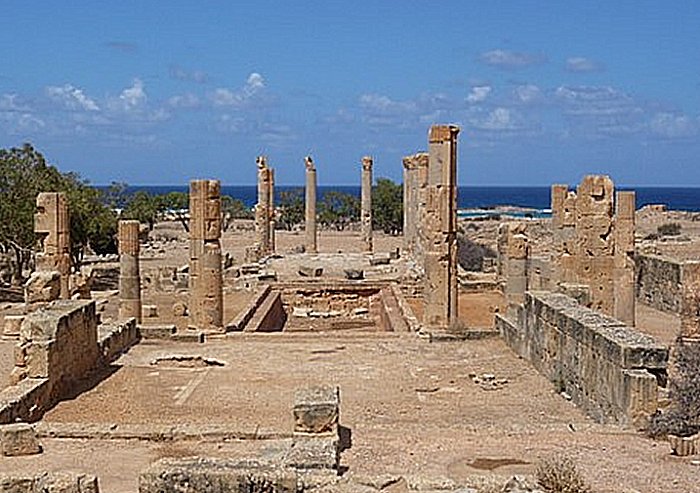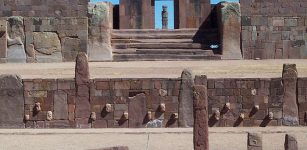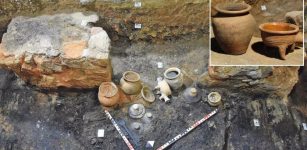University Of Warsaw Archaeologists Return To Study Large Ancient City Of Ptolemais
Conny Waters - AncientPages.com - After 13 years of absence due to the civil war in Libya, archaeologists from the University of Warsaw return to study Ptolemais, a large ancient city on the Mediterranean coast. One of their tasks will be to recreate the original coastline of the local port.
Polish archaeologists in Ptolemais
Ptolemais is one of the largest ancient Greek cities, located in Cyrenaica, a historical land now in north-eastern Libya.
The ruins of a palace at Ptolemais, east of Benghazi. Image credit:David Stanley from Nanaimo, Canada - CC BY 2.0
The city was founded by the Egyptian kings of the Ptolemaic dynasty who ruled Cyrenaica in the 3rd century BCE; it existed until the Arab conquest in the 7th century CE.
In late antiquity, it became the capital of a Roman province. Ptolemais is also a city that has not been covered by modern buildings. This allows archaeologists to study various aspects of the functioning of the ancient city and the life of its inhabitants using many scientific methods.
Archaeological research in Libyan Ptolemais was initiated in 2001by Professor Tomasz Mikocki from the Faculty of Archaeology of the University of Warsaw. It covered a quarter of residential buildings located in the centre of the ancient city. During the mission, the researchers discovered several houses, including the House of Leukaktios, richly decorated with wall paintings and mythological mosaics, also called the Villa with a View.
'Ptolemais is a city of unprecedented importance, one of the flagships of Polish Mediterranean archaeology', says Dr. Piotr Jaworski from the Faculty of Archaeology of the University of Warsaw, head of research at Ptolemais, in a press release.
Polish archaeologists had conducted research in this place for 10 years, until the outbreak of the Libyan revolution. Now, after a 13-year hiatus forced by the civil war, the mission of the Faculty of Archaeology of the University of Warsaw has returned. As reported by the University of Warsaw, the return was possible thanks to the concession for excavations and non-invasive research signed last year in Tripoli.
Antique mosaics and invasive tobacco
In June, an expedition led by Dr. Jaworski, together with specialists from the Academy of Fine Arts in Warsaw, carried out the first archaeological and conservation research in Ptolemais after the hiatus, and inventoried finds from the years 2001-2010. These are hundreds of crates with larger and smaller fragments of mosaics that have been moved to a new storage space.
'In general, this assessment was very good. There are no major damages. However, a completely unexpected threat appeared, namely, an expansive plant species - grey tobacco. It is all over the site, instantly growing into large shrubs. In many places it destroys the walls of the houses we study', describes Dr. Jaworski.
Villa of Columns. Image credit: Edratzer - (own work) - CC BY-SA 3.0
In the next excavation season, archaeologists from the University of Warsaw will continue their research, which was interrupted unexpectedly in 2011. 'So far, we have explored about a third of the insula, discovering the remains of residential buildings. In the area explored so far, there are three houses whose oldest phases of use date back to the Hellenistic period.
After their destruction as a result of the earthquakes in the 3rd and 4th centuries, craft activities developed in this area. We will continue excavations in this place', describes Dr. Jaworski. 'We will also continue surface and non-invasive research in selected areas of the city and the nearby rural areas'.
The ancient port of Ptolemais and the study of the coastline
Dr. Jaworski emphasizes the importance of completely new research that has not yet been carried out in Ptolemais. 'These are underwater studies of the ancient port, which we are planning for a number of years to come. For a large city like Ptolemais, the port was extremely important. We intend to explore the coast and recreate the original coastline in the port, because the water level has risen since antiquity, and the coastline has changed. The first step in this direction was scanning the seabed with a sonar', describes the archaeologist.
During the Polish researchers' absence in Ptolemais, local scientists discovered further inscriptions and coins. Their description is the next task for the Polish mission. 'We are now working on an inscription that contains the names of ephebes, i.e. young men who studied civics in the local gymnasium. This is a very important, but not the only inscription of this kind. Thanks to it, we are compiling an increasingly complete list of Ptolemais citizens', the expert explains.
Coins can also be used to determine major periods in a city's history, especially its economic history. Research on the monetary circulation may help explain when in the history of the city we can talk about periods of crisis and prosperity. They also help learn about the nature and main directions of the city's trade contacts. In total, archaeologists from the University of Warsaw have found about 3,000 coins in Ptolemais.
In the first stage of work, the experts also developed a conservation strategy for the coming years. 'Conservation care is extremely important to us, and a team of conservators will be permanently present on site. They will protect the site and excavated objects from destruction', describes the mission leader.
Written by Conny Waters - AncientPages.com Staff Writer






















